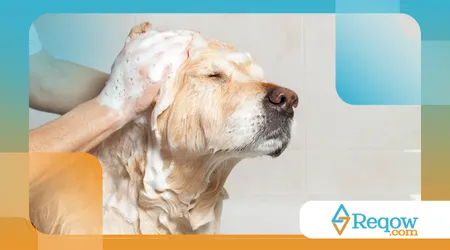How to Create a Bathing Schedule for Short and Long Haired Dogs

Create a bathing schedule for short- and long-haired dogs It is a necessity for responsible owners, as the appropriate frequency and method are crucial for the pet's health and well-being.
Advertisements
The coat, whether dense or sparse, serves as a protective shield against the weather and microorganisms.
However, it can also accumulate dirt and odors. It's important to understand that each dog has its own unique characteristics.
A Labrador's needs are very different from those of a Shih Tzu.
It's a common misconception that all dogs can be bathed equally often.
Advertisements
The truth is that the breed, lifestyle and even the health of the animal determine the best hygiene regimen.
Ignoring this individuality can lead to skin problems. Excessive bathing strips the skin of its natural oils, while insufficient bathing can cause infections.
The secret is finding the right balance.
The Ideal Frequency for Short-Haired Dogs
Short-haired dogs, such as Beagles and Boxers, generally do not require frequent baths.
Their shorter, denser coat tends to be easier to keep clean.
However, this ease doesn't mean neglect. Bathing should be a part of your routine, but with greater spacing.
Bathing every two to three months is a good rule of thumb. This interval can be adjusted depending on the dog's activity level.
A Beagle that lives in an apartment and takes short walks in the city, for example, doesn't get as dirty.
On the other hand, a Boxer that loves to play in the mud will require more frequent baths.
Regular brushing is a great ally for these pets. Brushing short hair once or twice a week helps remove dead hair and distribute natural oils.
This practice keeps the coat healthy and shiny. It also reduces the need for frequent baths.
For short-haired dogs that do a lot of outdoor activity, bathing can be done monthly.
This adjustment is crucial to prevent dirt buildup. The owner should monitor the condition of the animal's skin and coat.
If your skin is dry or itchy, the frequency of your bathing may be the problem.
The Ideal Frequency for Long-Haired Dogs
Long-haired dogs, such as the Golden Retriever or Shih Tzu, require special attention.
Their lush, dense coat is more prone to matting and dirt buildup, meaning they need to be bathed more frequently and thoroughly.
Read more: Paw Care Routine: Preventing Cracks and Wounds
A long-haired dog may need a bath every 4 to 6 weeks.
A bathing routine for these dogs should be accompanied by a daily brushing routine. Brushing removes knots and prevents matting.
Failure to brush before bathing can aggravate knots, making bathing your dog much more difficult. This preventative care is essential.
Brushing also stimulates blood circulation in your dog's skin. This stimulation is beneficial for the health of their fur, which grows thicker.
Many owners underestimate the importance of this step. A Golden Retriever, for example, can develop painful mats if not brushed regularly.
In addition to bathing, the use of dog-specific conditioners is recommended. They help detangle the fur.
Owners should also choose shampoos specifically for their pet's coat type. For a Poodle, a moisturizing shampoo may be the best choice.
Factors That Influence Creating a Bathing Schedule for Short- and Long-Haired Dogs
Several factors determine the ideal bathing frequency, and they go beyond coat length. The dog's age is one of them.
Puppies shouldn't be bathed too often, as their skin is more sensitive and their immune systems are still developing. Not bathing them early in life can also be harmful.
Another important factor is the dog's health. Dogs with skin problems, such as allergies or dermatitis, may require therapeutic baths.
Find out more: How to identify if your pet has a fever just by observing its behavior
In these cases, bathing frequency should be determined by a veterinarian. They can recommend the best shampoo.
The dog's environment also influences its health. A dog living in a rural area and getting dirty frequently will need more regular baths.
A dog that lives in an apartment and rarely goes outside has different bathing needs. The animal's lifestyle is the owner's guiding principle.
Humidity and climate also affect a dog's skin. In humid climates, dogs are more prone to developing skin fungus.
The owner should adjust the frequency of bathing to combat this problem. Attention to detail is what makes the difference.

The Power of Routine and Planning: Creating a Bathing Schedule for Short- and Long-Haired Dogs
Just like a symphony orchestra, where each instrument plays a unique role in creating a harmonious melody, bathing, brushing, and grooming are essential elements in your dog's symphony of care.
Each action must be performed precisely. Failure to do any of these steps can result in an off-key sound, or, in the case of your pet, skin problems and discomfort.
A practical example of how create a bathing schedule for short and long haired dogs it could be creating a table.
Look how interesting: When hair loss is more than just a change of seasons: signs of hormonal imbalance
The chart helps visualize your pet's care routine. It can include bath dates, grooming dates, and brushing frequency. This organization makes the owner's life easier.
Example Table: Care Schedule
| Pet | Race | Hair Length | Bath Frequency | Brushing Frequency |
| Max | Beagle | Short | Every 2-3 months | 1-2 times a week |
| Bella | Golden Retriever | Far away | Every 4-6 weeks | Daily |
| Toby | French Bulldog | Short | Every 1-2 months | Once a week |
| Luna | Poodle | Far away | Every 3-4 weeks | Daily |
The table above is just an example of how to organize your hygiene routine. The frequency can be adjusted.
A show dog, for example, may need more frequent baths to keep its coat looking impeccable.
A Shih Tzu that lives in a very dusty place needs more regular baths.
It is important to remember that bathing is not just a matter of aesthetics, but of health.
A study conducted by the American Veterinary Medical Association (AVMA) in 2023 revealed that 351,000 dog owners in the United States do not follow a regular bathing schedule.
This lack of routine is one of the main causes of skin problems in dogs, such as dermatitis and fungal infections. This demonstrates the importance of planning.

Special Care and Golden Tips on How to Create a Bathing Schedule for Short and Long Haired Dogs
In addition to the schedule, some precautions are essential. Never use human shampoo on dogs, as their skin pH is different.
Human products can cause irritation. Owners should always use quality products.
Another key point is drying. The dog must be completely dry after bathing, especially long-haired dogs.
Residual moisture can cause mold and bacteria. Using a dog dryer is recommended. It helps dry the coat quickly and safely.
A common mistake is drying your dog's fur with the hairdryer on the highest setting. Excessive heat can burn the animal's skin.
Ideally, use the dryer on a medium or cool setting. Owners should always test the temperature on their own skin before using it on their dog.
Have you ever stopped to think about how create a bathing schedule for short and long haired dogs can it be simple with the right information?
A well-defined routine saves time. It also prevents health problems in your pet. It's a way to show love and care.
To conclude, create a bathing schedule for short and long haired dogs it is not a luxury, but a necessity.
It's an act of love and responsibility. Following a veterinarian's instructions is the best way to ensure your pet's health.
The owner must always be attentive to the signs that the dog's body gives.
Frequently Asked Questions
1. Can I use human conditioner on my dog?
No. Dogs' skin pH is different from ours, and human conditioners can cause irritation and skin problems. Always use products specifically designed for dogs.
2. What is the best time of day to bathe my dog?
The best time is when the owner has enough time to bathe the dog without rushing. Make sure the dog is calm and relaxed, and that you have time to dry him completely.
3. What should I do if my dog is afraid of bathing?
Try to associate bathing with something positive. Use treats, toys, and praise your dog during the process. If the fear is too great, seek professional help.
4. Can I bathe my dog at home or do I need to go to a pet shop?
Both options are valid. If you have the right products and equipment and feel comfortable, you can give your dog a bath at home.
If you prefer, a professional pet shop has the experience and tools to do the job.
5. Is it true that long-haired dogs need more frequent baths?
Yes, long-haired dogs generally need more frequent baths. Their coats are more prone to tangles and dirt buildup, which can lead to skin problems.
++ Stress-free bathing! Transform your dog's routine with these tips
